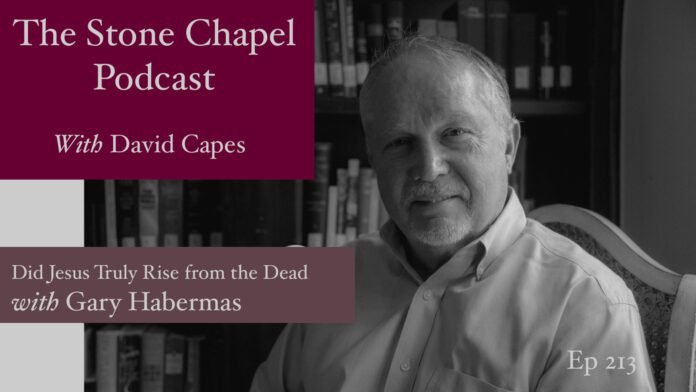► Listen on Amazon
► Listen on Apple
► Listen on Spotify
► Listen on YouTube
You can find previous episodes of “The Stone Chapel Podcast” at Lanier Theological Library.
“The Stone Chapel Podcast” is part of the ChurchLeaders Podcast Network.
This transcript has been edited for clarity and space.
Gary Habermas
Hi. My name is Gary Habermas. I am the Distinguished Research Professor in the School of Divinity at Liberty University in Lynchburg, Virginia.
David Capes
Dr. Gary Habermas, good to see you. Welcome to The Stone Chapel Podcast.
Gary Habermas
Thank you.
David Capes
For those who don’t know you, who is Gary Habermas?
Gary Habermas
I think I ask myself that sometimes! I’m living in Lynchburg, Virginia. I know a lot of people live places other than where they teach, but I’m in the city where my university is. I’ve had pastoral training, and then I have been teaching college or grad school since 1976. I came to Liberty in 1981, just five years after I began so I’ve been teaching there for 40 plus years. I only teach PhD courses right now, but I spend most of my time researching.
I’m married and we have seven children. In 1995 the mother of my four children died of stomach cancer. And it was a horrendous event for us. She was only 43 years old, and our children were young. Our youngest was nine years old, and it was obviously very tough on the family. Later a really good friend of the family who lived near us, and went to the same church began bringing food to us. She was single and rented out rooms at her house to women who were students at Liberty. We knew each other for a long time. And I guess she brought too much good food, because pretty soon after that we started hanging around each other and we got married a year later. We’ve been married for 28 years.
David Capes
You’re coming here to the Lanier Theological Library to lecture on November 9th, 2024. Your topic is the resurrection. Obviously, that’s what you’ve been thinking about and writing about now for all these years. What I wanted to do in our time together, Gary, was to tell people a little bit about that lecture, because we want to whet the appetite. We want all of our Houston friends and people in South Texas to come and visit with us during the lecture. We also want all those who listen out there to our podcast, on other continents, and in other countries to know about it. That way they can stream it wherever they are at that time and hear you talking about evidence for the resurrection of Jesus.
Gary Habermas
Resurrection. My favorite topic in the world. And sometimes I think it’s the only topic in the world! To me, it’s the main event in the gospel data. And if the gospel data is, he says 1 Corinthians 15:3. It’s the most important of the messages he gave. Then I feel I’m right where I need to be.
David Capes
If you could boil it all down what’s the big idea of your lecture coming up at the Lanier Theological Library in November?
Gary Habermas
The resurrection. And I presume that I’m going to be talking a lot about it. We’ll be talking about the event and what it means, and maybe the text and things like that. I presume that most of the lecture will be about grounding the resurrection evidentially, given the theme of the weekend, and outlining some of that evidence. In my case, that’s unpacking what I call the minimal facts argument. And I will try to take great pains to do a lot of detail on how that argument works. The first volume of this four-volume set is already out, and it’s almost 1100 pages. It’s on nothing but the evidence. If I’m trying to get through that, it’s going to be a whole lot to unpack, but I’ll try to give the most important element of the research.
David Capes
You talked about the minimal facts, the theory. What does that mean exactly?
Gary Habermas
I would define the minimal facts by two primary criteria. The first and by far the most important one is I will not use any facts which are not multiply attested. I will not use any of these facts which are not supported by many historical and textual arguments as a result.
The second point is quite a bit lower down the chart. But the second one is because I’m very careful about the facts. I teach and use virtually every contemporary critical New Testament scholar, theologian, New Testament historian. I will have virtually no problem going to state universities, private universities. I do it all the time. I’ll have no trouble presenting my facts and presenting evidence for them, because the critics are saying I’m okay with all that. Now, what are you going do with this? And we’re ready to move on.
In that first book on evidence, I use six primary facts. And of course, when I say six facts, each one of them has a load of data that go with it. So, it’s not just six facts by themselves, but six facts plus the attending data. When I was finished this with volume one and averaged it, the six facts are each supported by about 14 evidences. So, there’s a lot of data. When people are given reasons in books, they often give two or three for whatever view they’re holding. But 14 per item maybe is a little hint as to why critics are not objecting to the use of those facts.

